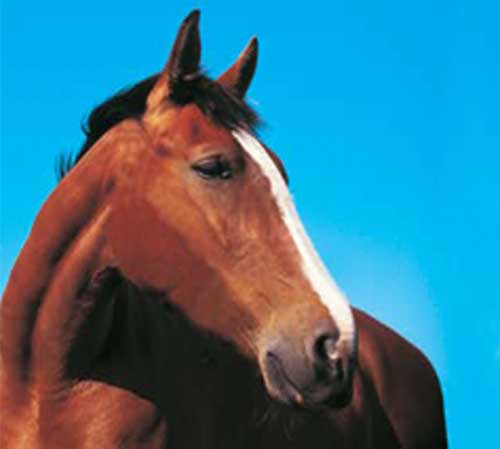Unfortunately insulin resistance, metabolic disorders and even laminitis are far too common in today’s horses. Most horse people have heard these terms but what do they really mean? Why are some horses obese? Should you restrict a fat horse’s diet? What is going on in their bodies?
To get the answers to these questions and find out how to empower ourselves to prevent and understand insulin resistance, laminitis and metabolic disorders, I spoke with Dr. Joseph Thomas, Ph.D.
Lisa: Before we jump into the nitty-gritty, can you tell us about your background and how you got involved helping horses with insulin resistance and related conditions.
Dr. Thomas: I think it’s important that people understand my background as I am presenting a model that is more western in nature but my treatment is always Chinese herbs. I was a MIT research scientist in the department of brain science and was doing medical research, which should give people an idea why I can talk about research so fully. Ethics entered my world and I realized that I was doing what I considered unethical behavior with the animals we were using. But all things lead to your destiny and I found my first teacher of Chinese medicine. For the next 20 plus years I taught, consulted and practiced, specializing in internal medicine for the most serious of illnesses.
I have always loved horses. My wife, Crystal, and I have five horses and two of them came down with laminitis. Although I had been practicing medicine on humans, I never thought of using it on horses but it was so frustrating because no one could help our babies. After 11 years, I’ve reached this point in Chinese medicine with horses. The research part of me never stops and I research every day. It’s so nice now to be in a profession where I’m helping these lovely creatures.
Lisa: You can add my own horse, Riley, to that list. He’s lost 100 lbs., thanks to you helping me recognize this condition. Let’s start with an explanation of this metabolic disorder.
Dr. Thomas: My research has taken me to looking at the model of diabetes. So let me call into play the definition of diabetes, taken out of a clinical diagnosis. It’s a disease in which the glucose levels in the blood are elevated because of deficient insulin or abnormal insulin action.
Glucose is a form of sugar whose job it is to give nurturing and sustaining life energy to all the cells in the body. Now, if high glucose is in the blood, that means it’s not getting into the cells. That’s the beginning.
Glucose is hanging around in the blood because insulin, which is secreted by the pancreas, is not functioning properly. Insulin’s job is to push glucose into the cells. In the very early stages leading to diabetes we find incredibly high insulin but we have low to normal glucose.
Keep in mind this is before any horse owner or any veterinarian notices anything. Fortunately, you noticed something in Riley because that’s where he was when you contacted me. He had very high insulin and his glucose was perfectly normal. By definition, he is not laminitic, and not diabetic and yet this is where it begins. What we do have to worry about is that he is a horse that will be a laminitic candidate. This is a disease of metabolism.
Lisa: How does it progress from there?
Dr. Thomas: Insulin resistance means that there is high insulin and high glucose. As the disease progresses, you have all this insulin being secreted out the pancreas by beta cells, but glucose is low. We have this inordinate amount of insulin hanging around in the blood and pushing glucose into cells and everything looks fine. Except the beta cells get overused and start dying off. As they die off, insulin starts becoming deficient.
What we’re seeing in this genetic disease is the classic definition of diabetes – low insulin and high glucose, and now we have the conditions set up for a laminitic episode.
Lisa: So let’s cover “easy keepers” and the genetic connection. For Riley, we were so very careful with him; he was a coupleweek- old orphan who had a great diet – low starch and low sugar – from the get go. Because he is a pony breed, I had an idea he might be prone to an insulin resistance issue. But a great diet can’t change genes, right?
Dr. Thomas: That’s why I want people to understand that this is diabetes. Let’s break diabetes into two types – Type 1, which comes on very early in life and requires you to take insulin and Type 2, the model that is identical to metabolically challenged horses, which comes on later in life because of the process I talked about. A horse or human is born with a gene, called a thrifty gene, and therefore predisposed to diabetes.
The “easy keepers” are horses born with this gene so it’s going to eventually emerge, even if they’re on an appropriate diet. I certainly don’t think people should be feeding their horses sweet feed, grain, etc. because horses are foragers; allow them to eat what nature intended. But with horses like Riley, who have the gene, the condition does eventually come out and involves the relationship between the liver and the pancreas.
Many people have this notion that an “easy keeper” horse is heavy and has fat depo its because he eating too much. Really, it’s because of a metabolic disease like insulin resistance that primarily involves the pancreas and liver. It interferes with the digestion and the absorption of fats and free fatty acids. When you have conditions set up where you have excess glucose in the blood due to a carbohydrate dysfunction, the liver tries to regulate the excess because the body is always trying to heal. The liver tries to regulate the excess glucose by synthesizing the carbohydrates into triglycerides. Most people know this word – it’s a neutral fat.
This happens because these fats function as a storage unit for excess glucose and carbohydrates. Triglycerides keep filling and the liver keeps producing more of them until the triglyceride level becomes elevated in the blood. The liver gets fatty and starts bumping out fat globules in the form of fatty cysts that travel out to the muscles and peripheral areas like the neck, shoulders, tail head, and above the eyes. These are the fatty globules being pumped out of the liver to regulate the excess glucose. That’s why an “easy keeper” looks that way – it’s their body’s attempt to heal the excess glucose. An easy keeper is not over-eating.
Lisa: Yet many people cut back their horse’s feed?
Dr. Thomas: Yes, and it’s so dangerous to seriously restrict their horses’ feed. People think they’re doing well because, if we take the weight off, the horse won’t become laminitic. But remember, they’re fat because of the metabolic disease, not because of eating too much.
Lisa: What can happen if a horse like this has his feed cut back?
Dr. Thomas: There is a condition known as acidosis which results from the accumulation of acid or the secretion of an alkaline reserve, which is the opposite pH of acid. This is measured by a blood test called total bicarbonate and this is low in a diabetic horse that has been starved of food. In severally uncontrolled diabetes and laminitis, the horse can die; they lie down, can’t breathe, go into a coma and die. It’s often misdiagnosed because no one is reading about it.
Lisa: Thanks so much for sharing your insights. I’m sure many horse people will be watching out for these conditions now.
Metabolic disorders in horses don’t have to be a mystery for the everyday horse guardian. By keeping the basic points in mind, understanding the progression, and knowing where to turn for help, this disease does not have to develop into laminitis. In the next issue, we’ll cover how diabetes leads to laminitis.
Diet hints for metabolically challenged horses
•Cut out starches and sugars such as grain, molasses, sweet feeds, and rich grass.
•Watch sugar levels in hays. Cool season grasses such as Timothy, Brome, orchard and fescue can be high while warm season types such as Bermuda and native prairie grasses are lower. Visit www.safergrass.org for more information on sugar content of hays.
• Do use high fat/low starch feedstuffs such as rice bran and flaxseed.
•Provide free-choice grass hay.








